Meeting the Escalating Demand for Mental Health and Well-Being Support
Executive Summary
Beyond the counseling center, many other departments, faculty, and staff across campus are experiencing increased demand for well-being support.
National data shows that counseling center utilization has grown five times faster than enrollment. Changing social norms, shifting demographics, and intensified external pressures are all factors contributing to the collective surge of demand. By all indications, the demand for campus services will continue to grow as adolescents are experiencing higher rates of anxiety, depression, and other mental health concerns.
There are significant risks in failing to meet students’ mental health needs.
Leaders recognize the high stakes associated with increased demand and delayed access to mental health supports, including risks related to campus safety and student welfare. Students’ mental health concerns and access to treatment also impact key institutional goals, such as academic performance, retention, and completion.
Hiring additional clinical staff is not a sustainable, long-term solution. Even well-resourced counseling centers struggle to keep pace with demand.
Many institutions have already heavily invested in clinical and professional staff. EAB research reveals a growing recognition among campus leaders that investing in staff cannot completely manage students’ increased demand. Moreover, continually investing in staff is rarely an option due to limited or tapped out financial resources.
- Set and Communicate a Sustainable Scope of Service
Clearly define what types of care will—and will not—be available through campus services. Proactively communicate expectations to students and families in order to support early planning. - Design a Network of Scalable, Personalized Options Beyond Counseling
Organize campus resources into a network that can be effectively scaled and personalized to a broad spectrum of students’ needs. Centralize existing campus-wide supports that help students understand the range of options available to manage their concerns. - Proactively Integrate Support Across the Student Experience
Target interventions to known pain points to mitigate common stressors and setbacks from escalating to more significant challenges. Infuse skill-building opportunities and interventions through day-to-day interactions with students, in and out of the classroom.
Every Year Is Record Breaking
Demand for Campus Mental Health Services Continues to Soar
Students’ demand for campus counseling service and mental health support continues to escalate. Year over year, colleges and universities struggle to keep pace with the volume of students seeking support on campus. From 2009 to 2015, counseling center utilization grew five times faster than enrollment. National data shows that anxiety, depression, and stress are the most common concerns among today’s college students.
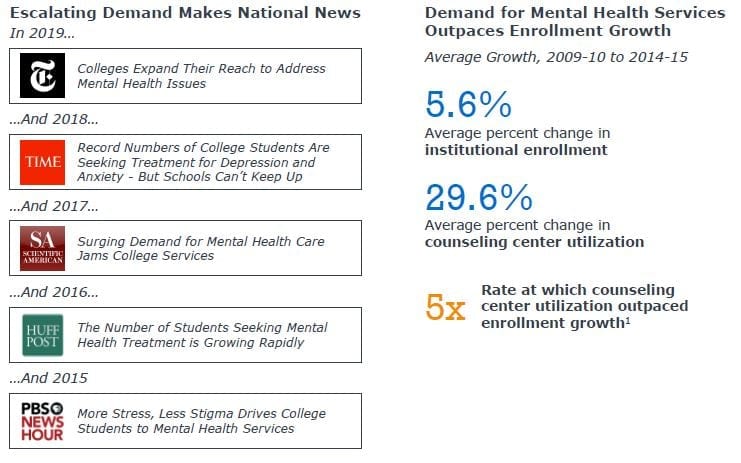
A Perfect Storm
Several Converging Factors Explain the Surge of Students Seeking Support
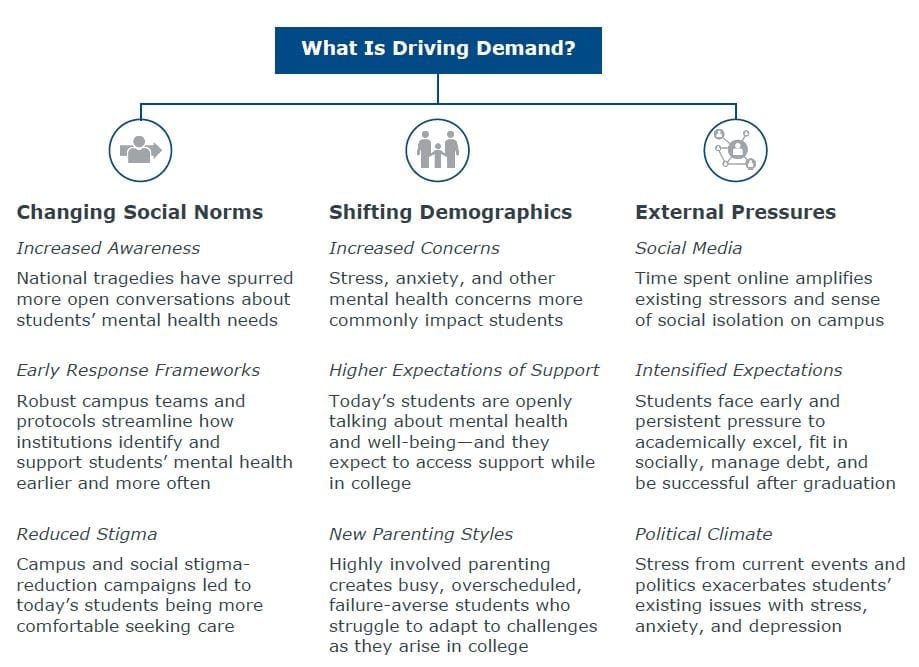
No End In Sight
Anxiety and Depression Are on the Rise Among Today’s Teens
By all indications, the demand for campus services will continue to grow. Today’s adolescents are experiencing higher rates of anxiety, depression, and other mental health concerns. The majority of teens see anxiety and depression as a major problem among their peers.
When these students arrive on campus, they are thrust into a new environment with significant stressors that can exacerbate existing concerns. These students—and their families—increasingly expect colleges and universities to provide treatment options and assistance.
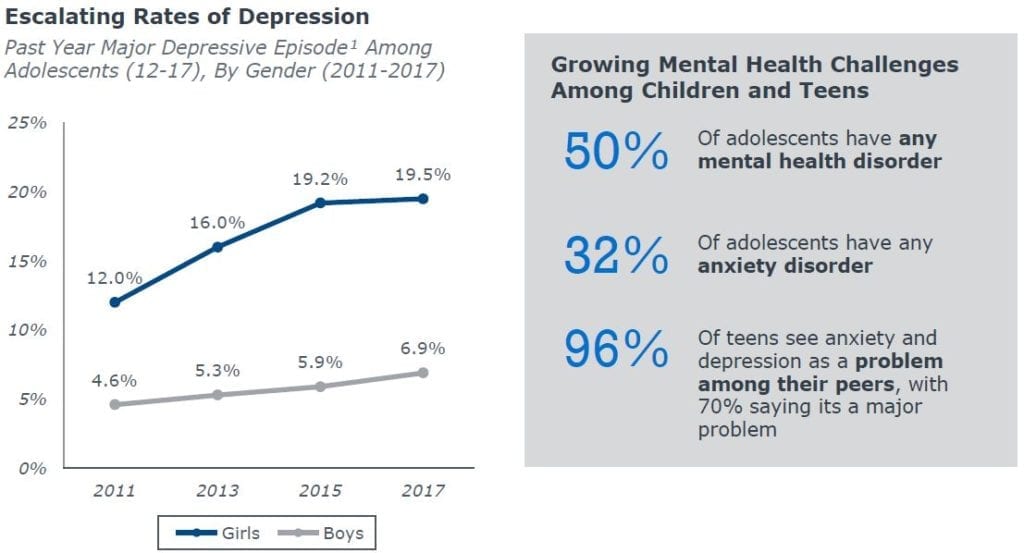
Not Just Waitlists in the Counseling Center
Impacts of Increased Demand Are Felt Across Campus
As more students come forward seeking treatment and support on campus, colleges and universities are feeling the strain on available resources. Most often, counseling centers are feeling the demand through increased waitlists for individual therapy appointments, staff burnout, and less time and resources for outreach, early education, and other priorities.
Beyond the counseling center, many other units across campus are also feeling the consequences of increased demand. For example, faculty and staff are increasingly expected to help students with common mental health and well-being challenges through one-on-one conversations, classes, and day-to-day interactions.

The Consequences of Not Addressing Mental Health
A Variety of Impacts
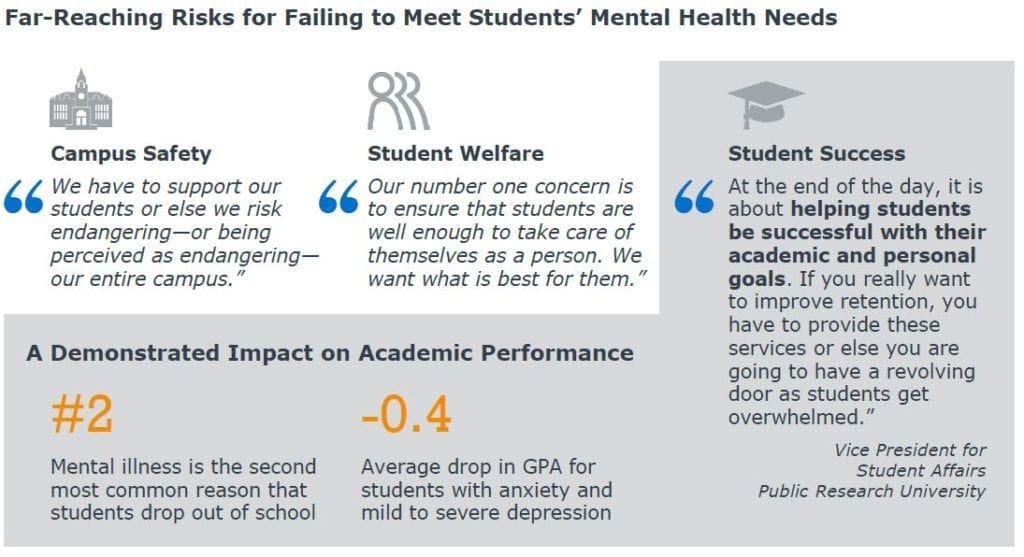
Investing in student behavioral health does have a quantifiable longterm economic impact…studies show that 30% of depressed college students will drop out. With treatment, 6% of these dropouts can be averted. If a counseling center works with 500 students, this investment will generate more than $3 million in lifetime earnings.
Daniel Eisenberg, Director Healthy Minds Network
Simply Hiring More Staff Is Not a Viable Answer
Sustained Demand Leaves Institutions Searching for a New Model
In recognition of the high stakes associated with helping students manage their mental health and wellbeing, many institutions have invested additional resources in campus counseling centers and related supports. Notably, several institutions have invested in additional personnel (including clinicians, psychiatrists, case managers, and other professional staff) to meet the need for on-campus support.
However, most colleges and universities do not have the financial resources or available hiring pools to continually invest in more specialized personnel. Because increasing personnel is not a solely viable solution, institutions must explore new approaches to meeting the escalating demand for mental health and well-being support.
Many Institutions Have Invested in Additional Counseling Center Staff…

…But It Is Not Enough
Even those institutions that funded additional counseling staff report that the ongoing demand continues to outpace the availability of providers. In other words, colleges and universities have not been, and likely will not be, able to staff their way out of this problem.
Aaron Krasnow, AVP, Health & Counseling Services, Arizona State University
Time for a New Approach
How to Strategically Invest In Campus Mental Health and Well-Being Support
To meet the rising demand for mental health services, EAB identified three recommendations to improve how your institution supports students’ mental health and well-being.
The following pages provide an overview of each recommendation and case examples of how progressive institutions are addressing students’ needs. EAB recommends senior leaders discuss these recommendations as part of developing and/or refining your institution’s strategy to meeting the escalating demand for support on campus.
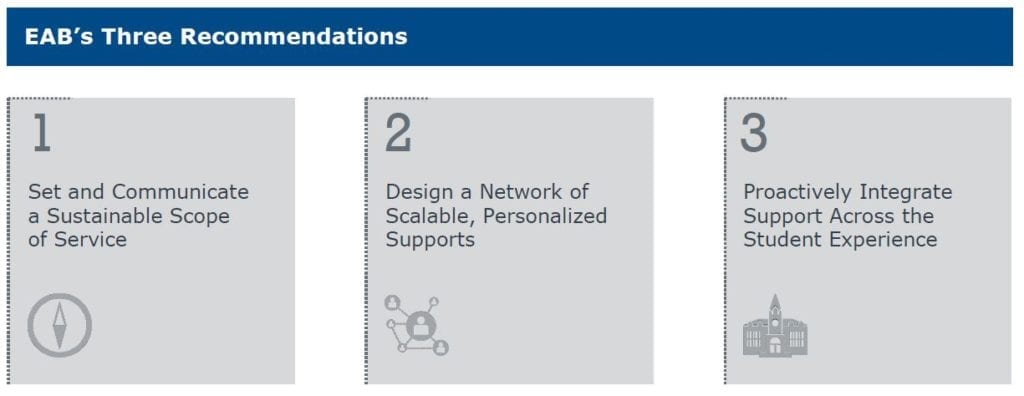
Finite Resources Can Only Go So Far
Increasingly, Institutions Can’t Do It All
The rising demand for services and the complexity of mental health concerns prompts difficult questions about the scope of campus care, including what services to invest in and what types of concerns should be managed on campus. Institutions increasingly recognize they cannot provide all types of services to all students with finite resources. As campus leaders and administrators determine what to prioritize, they are often weighing two values: accessibility and intensity.
“Where Should We Focus Our Resources?”
Accessibility
Prioritizing Quick Access for All Students
- Clinical resources used to help a greater number of students solve short-term challenges
- High-need students are referred off campus for long-term care
- Intake, triage, and walk-in hours reduce wait times for all students
Intensity
Prioritizing Ongoing Treatment for High-Need Students
- Clinical resources devoted to treat a small group of high-need students
- Little to no reliance on community resources to provide care
- Reduced access or longer wait times for noncritical cases
As institutions, we all have to determine if we are going to meet every student’s needs, reserve resources for students who need them most, or see as many students as we can to get them in an appropriate place to be successful on campus.
Gillian Berry, Interim Director of Mental Health Services, The George Washington University
Recommendation #1: Define Your Institution’s Scope of Care
EAB recommends setting and sharing a clear scope of service statement that outlines the parameters of campus services. The process of defining the scope of care is critical to meeting increased demand and setting and communicating expectations early with students, families, faculty, and staff.
Recommendation #2: Design a Network of Scalable, Personalized Options
EAB recommends institutions organize campus resources into a network that can be effectively scaled and personalized to a broad spectrum of students’ needs. Having a central support framework helps students understand the range of options available to manage their mental health and well-being concerns.
Recommendation #3: Target Interventions to Known Pain Points
EAB recommends institutions proactively integrate support to help students successfully navigate common stressors, personal setbacks, and academic challenges. Institutions should target interventions to known pain points to help prevent common setbacks from escalating to more significant challenges. By proactively addressing high-stress moments, institutions can get ahead of demand for more intensive treatment and support options.